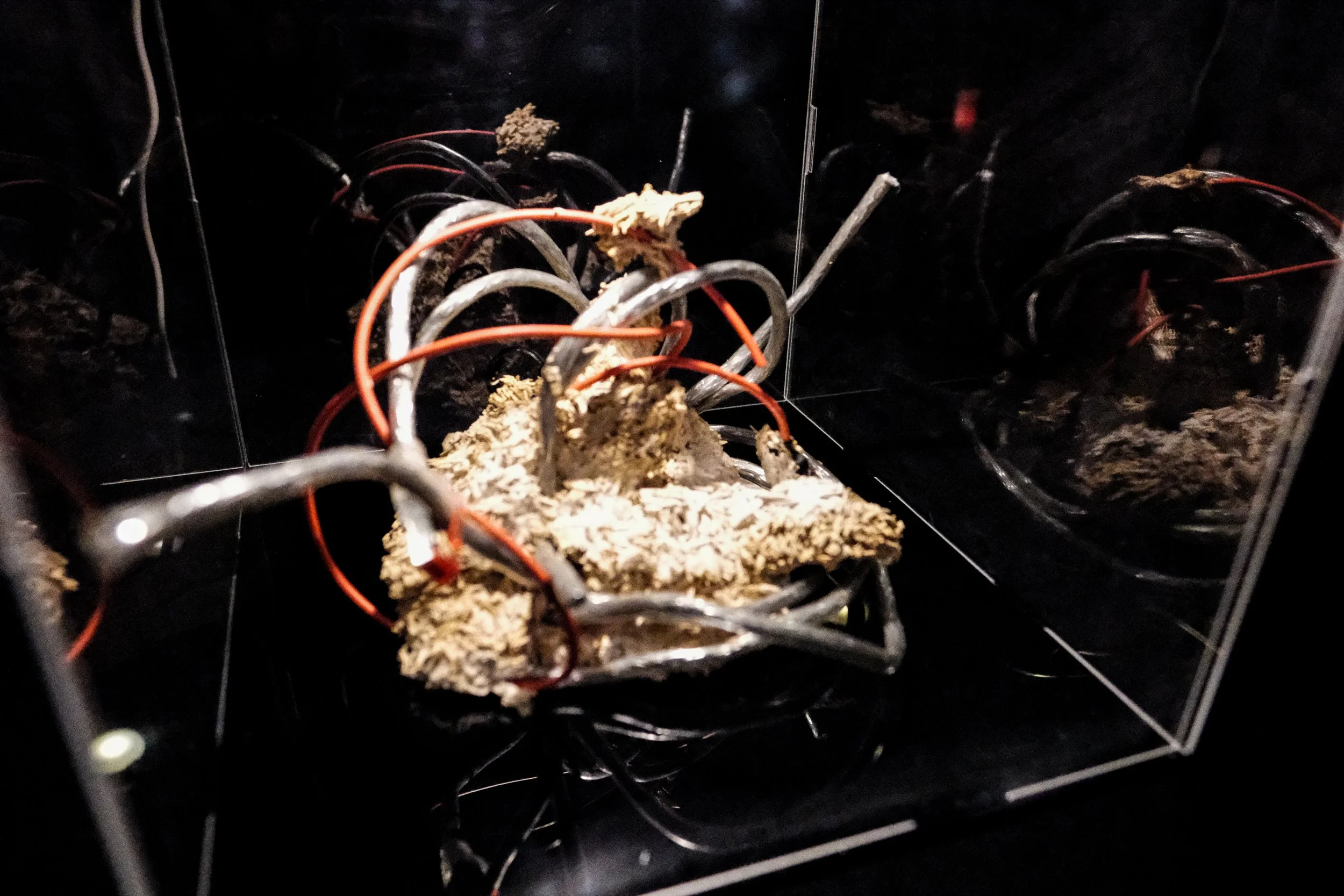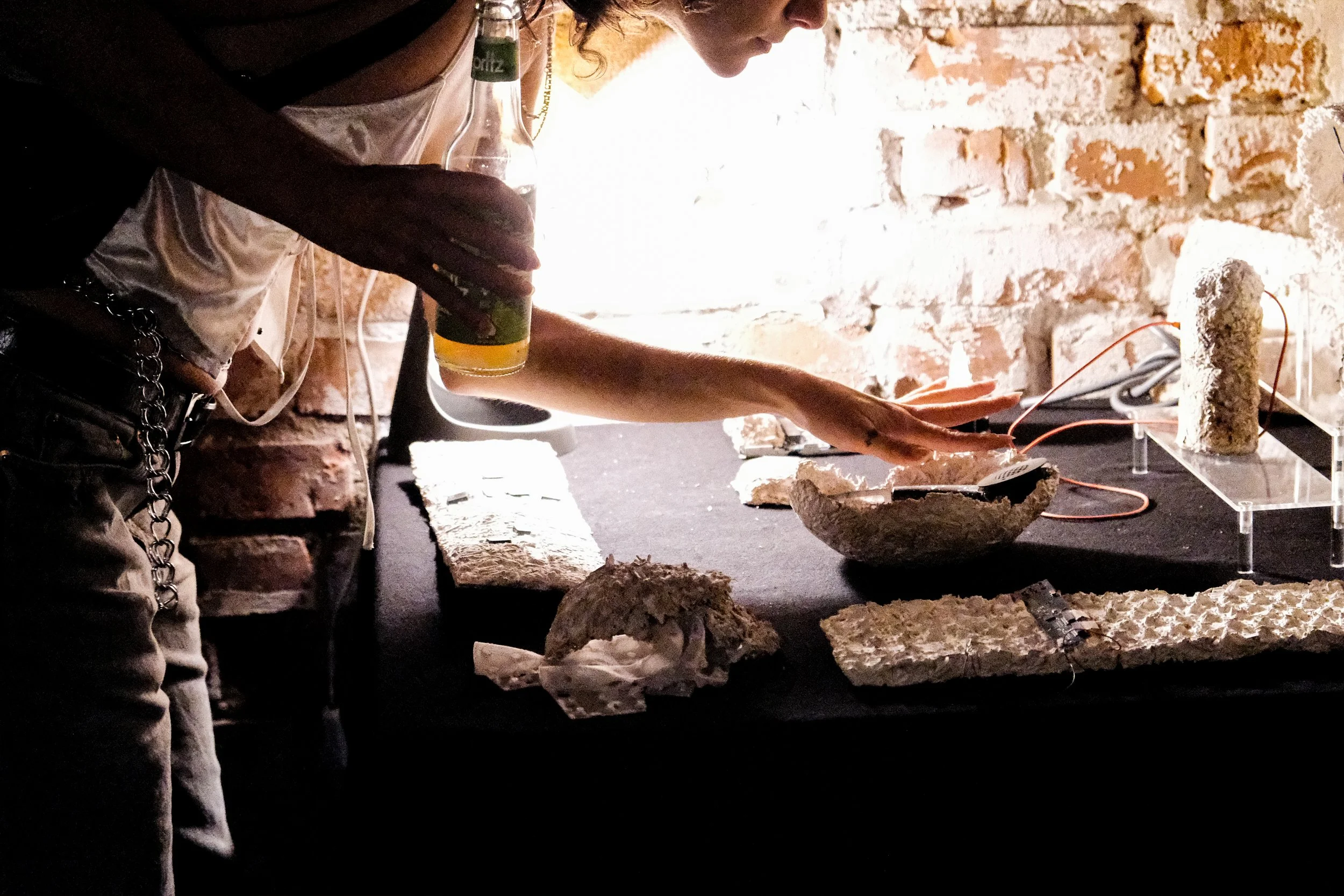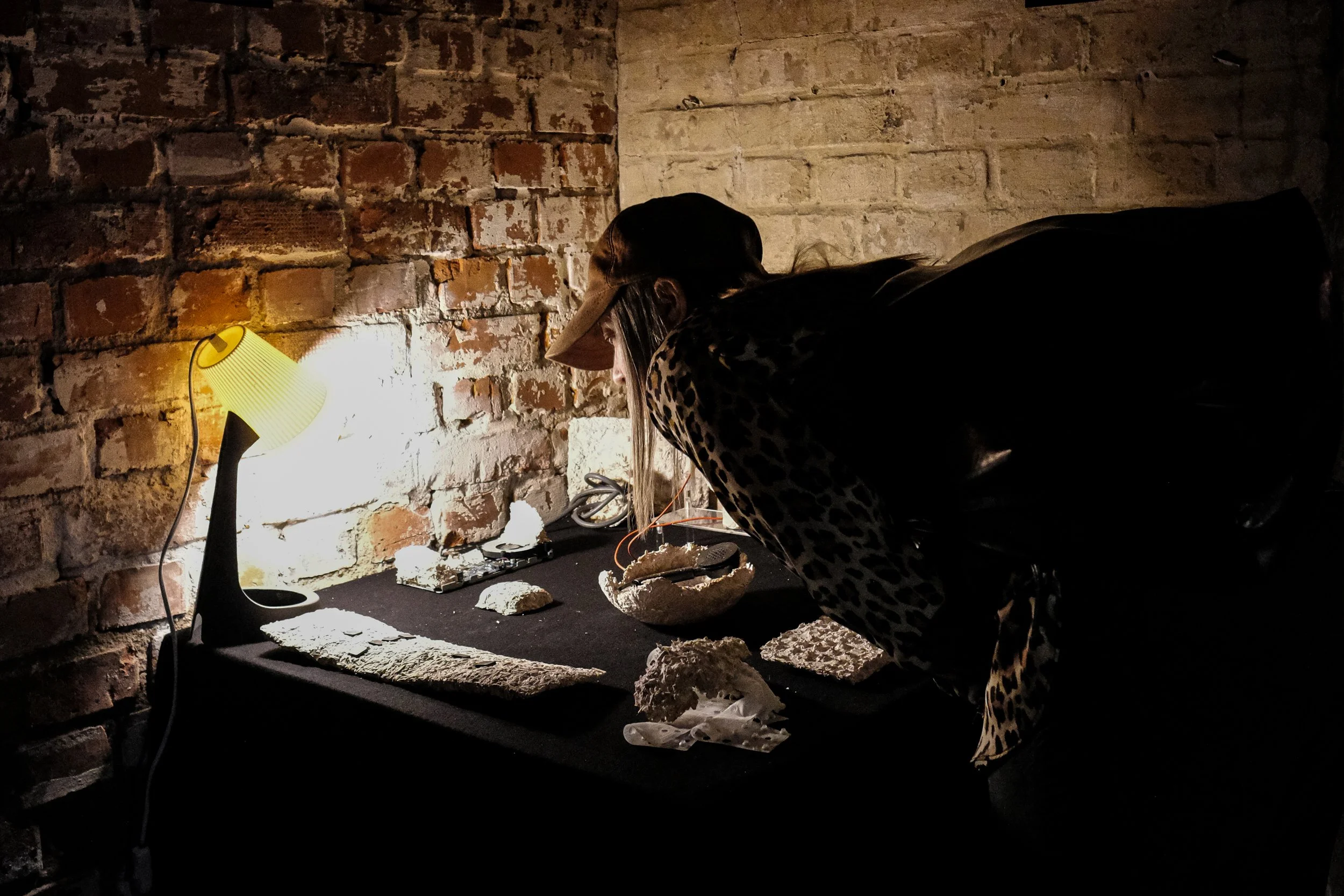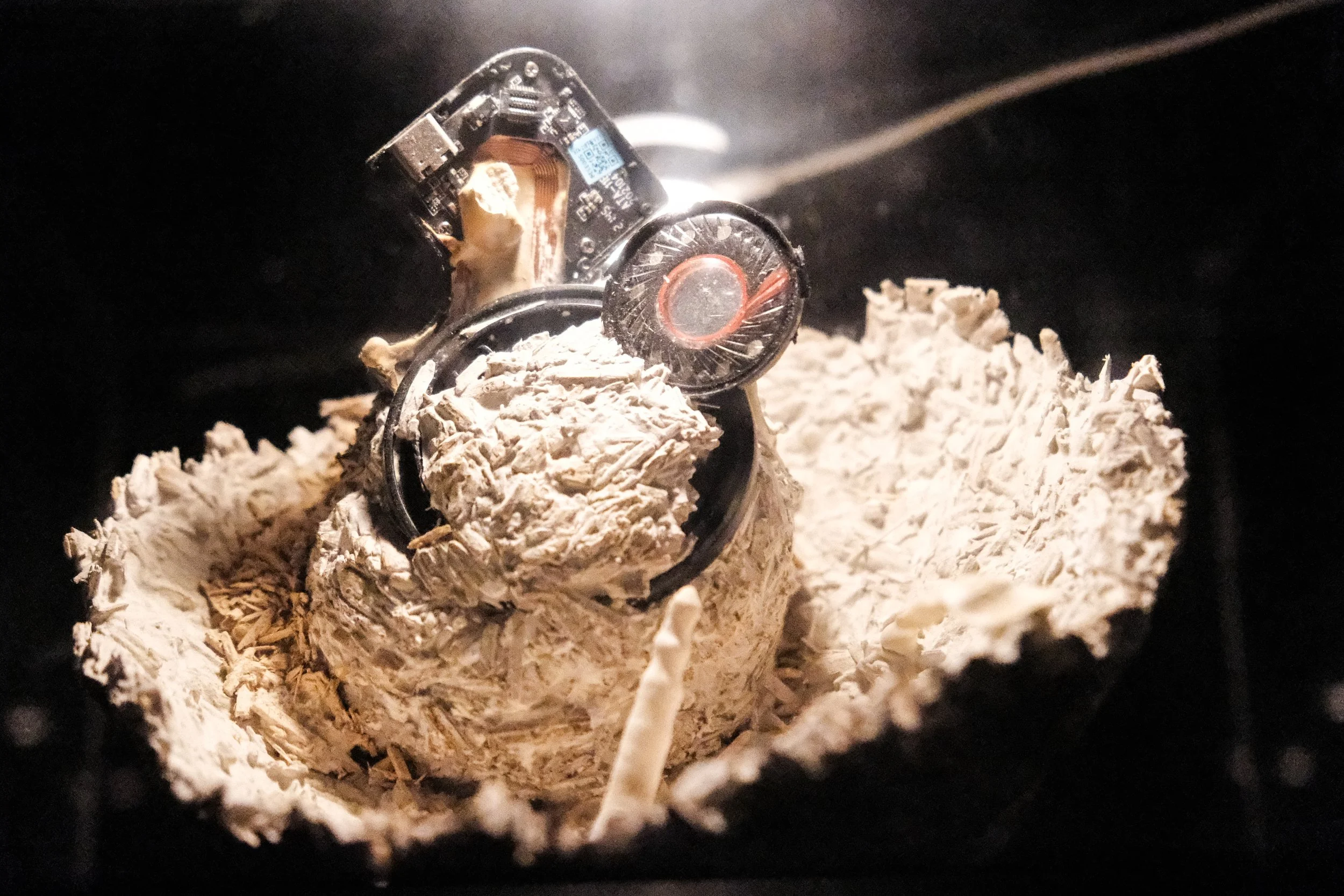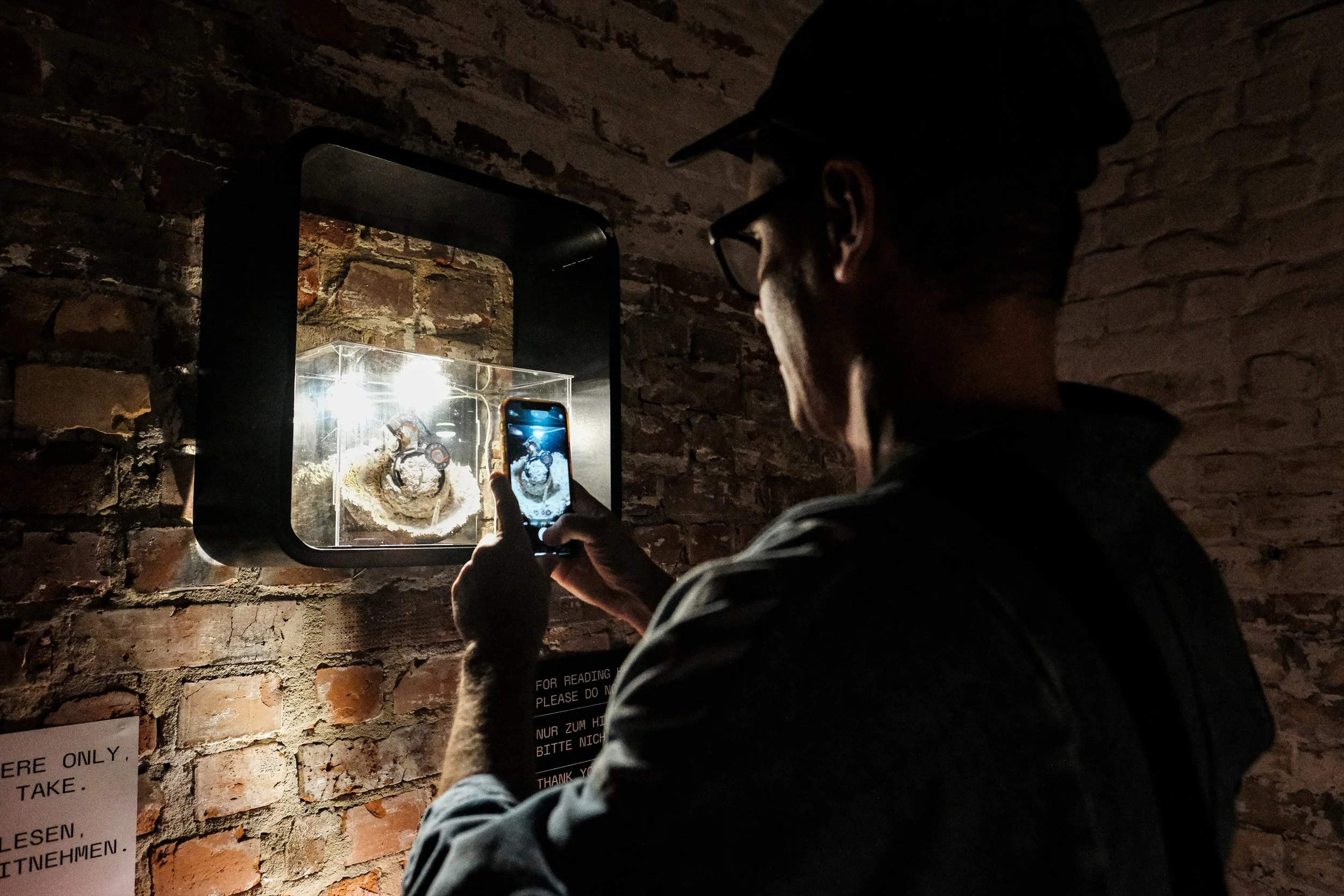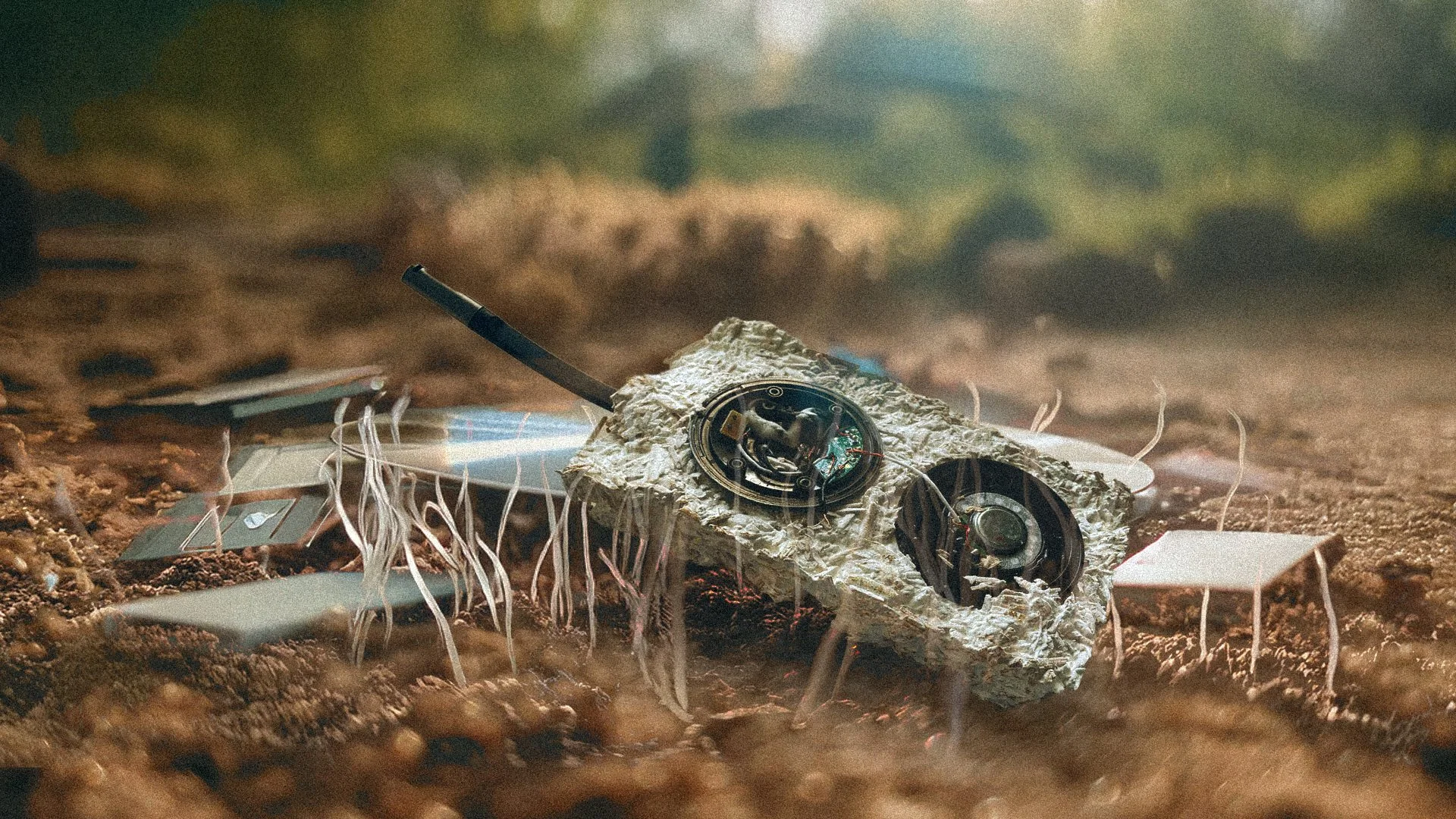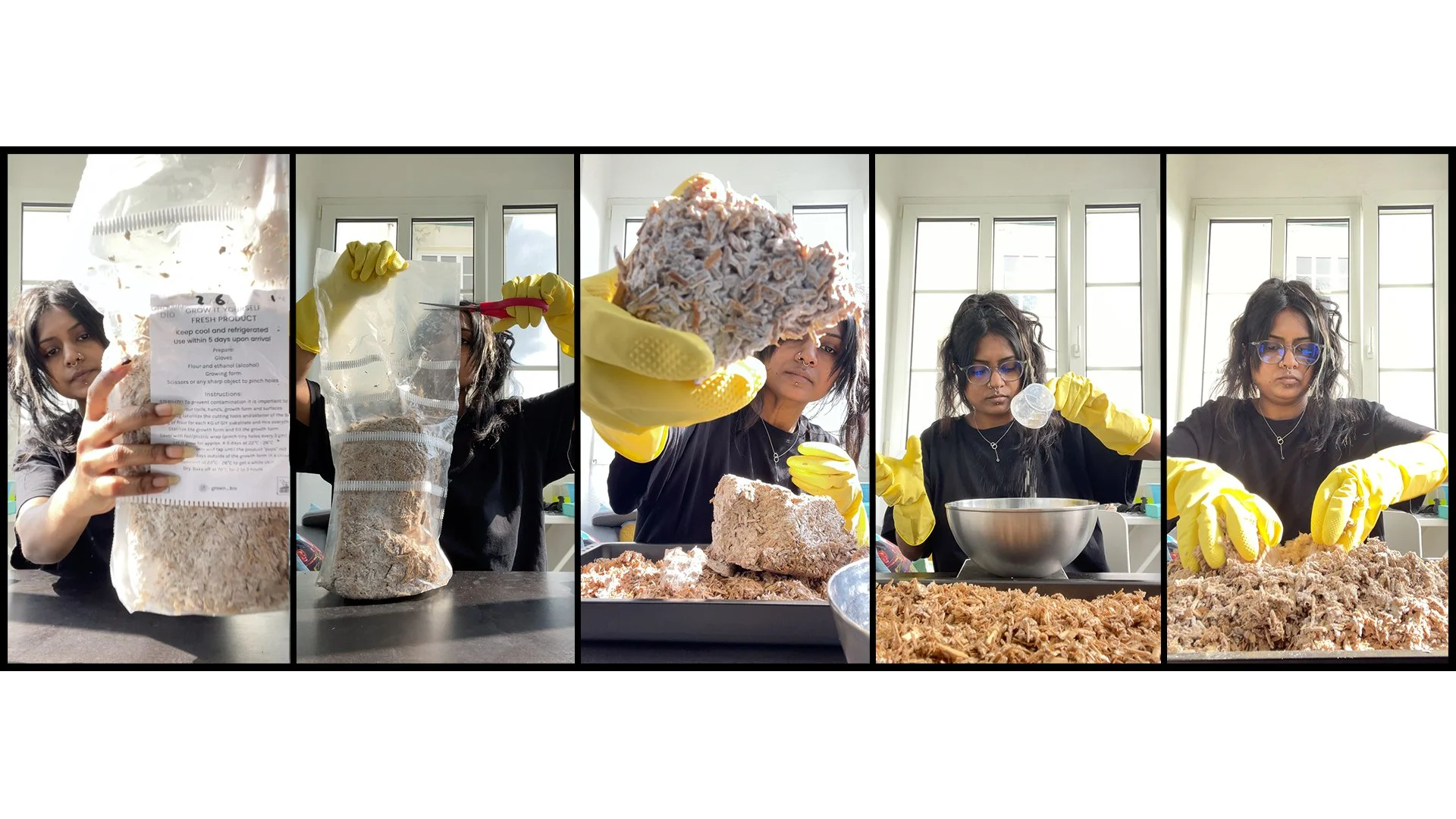Entangled Systems.
Photo by Ayça Tuğran
DIGITAL MEDIA OBSOLESCENCE // E-WASTE
FORESIGHT RESEARCH // SPECULATIVE DESIGN // GROWING DESIGN // MATERIAL SCIENCES // MEDIA ECOLOGY & MATERIALITY
MATERIAL DRIVEN DESIGN // BIOMATERIALS // SCULPTURES
-
Speculative design research
(M.A. Thesis Research and project) -
Berlin, Germany
University of Europe for Applied Sciences -
e-waste, IT specific (wires, keyboards, headphone, hard disks, earphones, cables etc), mycelium composite (from grown.bio)
-
Item descriptio
Berlin New Media Week (Sept 2025) & MaHalla Open for Berlin Art Week (Sept 2025) as a part of the curated exhibition ‘Intelligent Kin’ at MaHalla, Berlin.
n
Project Type
Speculative design research
(M.A. Thesis Research and project)
Berlin, Germany
Univerisity of Europe for Applied Sciences
Location
e-waste, IT specific (wires, keyboards, headphone, hard disks, earphones, cables etc),
mycelium composite (from grown.bio)
Materials
Berlin New Media Week (Sept 2025) & MaHalla Open for Berlin Art Week (Sept 2025) as a part of the curated exhibition ‘Intelligent Kin’ at MaHalla, Berlin.
Exhibitions
-
Entangled Systems is a speculative material inquiry beyond the obsolescence of discarded digital media—an experiment in the interplay between digital media waste and fungal networks.
In this museum of obsolescence, imagined, reside renewed living systems, found growing in electronic waste landfills.
Set 100 years in the future, it envisions a world where obsolete technologies, buried in the soil, have evolved without human interference and become entangled with non-human ecologies. Living sculptures of mycelium and obsolete media explore how decaying digital forms meet fungi—and the hybrid bio-digital materialities that may emerge. It reframes obsolete digital media as living repositories of memory, both material and digital.
And finally, prompts us to rethink digital media not as ephemeral things, but as living systems, hopefully encouraging more responsible and conscious design practices in the future.
““When you go to the toilet, shit disappears. You flush it.
Of course, rationally, you know it’s there, in canalization and so on, but at a certain level of your most elementary experience, it disappears from your world.””
How will digital media waste evolve beyond it’s designed obsolescence?
Listen to what could be.
Listen to what might be.
| Photos by Ayça Tuğran |
Entangled systems exhibited as a part of the exhibition ‘Intelligent Kin’ at MaHalla Berlin during Berlin New Media Week & Berlin Art Week
<Sept 2025>
REDUCTIO AD ABSURDUM
>>>
REDUCTIO AD ABSURDUM >>>
“A form of logical argument in which ‘a claim is assumed for the sake of argument, and it derives an absurd outcome by taking it to the extreme, concluding the original claim must have been wrong because it led to such an absurd result’.”
THESIS (ASSUMED) CLAIM
All digital media eventually die.
Their death is inevitable.
THE ABSURDITY
The obsolete media continue to live on, take new material forms, and interact with
non-human entities - fungi.
MUSEUM OF OBSOLESCENCE
>>>
MUSEUM OF OBSOLESCENCE >>>
Uncovering Archived Digital Media Fossils,
100 years later.
WHAT IS FOUND?
The obsolete media continue to live on,
take new material forms, and interact
with non-human entities - fungi.
GROWING PROTOTYPES
>>>
GROWING PROTOTYPES >>>
-
Cubitt, S. (n.d.). Framed: Sean Cubitt. Retrieved June 19, 2025.
Dhanani, R. (2025). The history of planned obsolescence | Timeline infographic. The Sustainable Agency. https://thesustainableagency.com/blog/the-history-of-planned-obsolescence/
Dunne, A., & Raby, F. (2013). Speculative everything: Design, fiction & social dreaming. The MIT Press. https://dunneandraby.co.uk/content/books/690/0
E-waste facts and statistics. (n.d.). Business Waste. Retrieved June 23, 2025, from https://www.businesswaste.co.uk/your-waste/weee-recycling/e-waste-facts-and-statistics/
Eva-Maria, W. (2024). ChatGPT’s power consumption: Ten times more than Google’s.Heise Online.https://www.heise.de/en/news/ChatGPT-s-power-consumption-ten-times-more-than-Google-s-9852327.html
ewastemonitor. (2024, March 20). The global e-waste monitor 2024.E-Waste Monitor.https://ewastemonitor.info/the-global-e-waste-monitor-2024/
Examined life [Documentary]. (2009). Sphinx Productions. https://www.imdb.com/title/tt1279083/
Ferrell, M. (2021, June 22). Is fungus the plastic of the future? - Undecided with Matt Ferrell.https://undecidedmf.com/episodes/is-fungus-the-plastic-of-the-future/
Gabrys, J. (2013). Digital rubbish: A natural history of electronics. The University of Michigan Press. https://library.oapen.org/handle/20.500.12657/24019
Gabrys, J., Starosielski, N., & Walker, J. (2016). Re-thingifying the internet of things.https://research.gold.ac.uk/id/eprint/18074/1/Gabrys_Rethingifying_SustainableMedia.pdf
Hertz, G., & Parikka, J. (2012). Zombie media: Circuit bending media archaeology into an art method. Leonardo, 45(5), 424–430. https://doi.org/10.1162/LEON_a_00438
Joe, T. (2021, February 22). ’Shroom FitBit: Processors in tech wearables could be replaced with fungi mycelium, new study finds.Green Queen.https://www.greenqueen.com.hk/processors-in-tech-wearables-like-fitbits-could-be-replaced-fungi-mycelium-new-study-finds/
Kloiber, J., & Jain, A. (2023). From active hope to tangible realities: An interview with futures leader Anab Jain.Ding Magazine.https://dingdingding.org/issue-5/from-active-hope-to-tangible-realities-an-interview-with-futures-leader-anab-jain/
Karana, E., Barati, B., Rognoli, V., & Zeeuw van der Laan, A. (2015). Material driven design (MDD): A method to design for material experiences. International Journal of Design, 9(3), 35–54.
Karana, E., Blauwhoff, D., Hultink, E.-J., & Camere, S. (2018). When the material grows: A case study on designing (with) mycelium-based materials. International Journal of Design, 12(2).
London, B. (2014). Ending the depression through planned obsolescence. Revue du MAUSS, 44(2), 47–50.
Material Atlas. (2019). The growing pavilion.https://thegrowingpavilion.com/material-atlas/
Material Matter. (2018). Jovis Verlag GmbH.
McLuhan, E. (2018, April 29). Eric McLuhan: “Media ecology in the 21st century” [Video]. YouTube.https://www.youtube.com/watch?v=dbs3Fp0Uu5k&t=2775s
McLuhan, M., Fiore, Q., & Agel, J. (1967). The medium is the massage. Gingko Press Inc.
Merlin Sheldrake. (2021). Entangled life: How fungi make our worlds, change our minds, and shape our futures.https://www.merlinsheldrake.com/entangled-life
Merlin Sheldrake - how fungi make our worlds - YouTube. (2025, June 11). YouTube.https://www.youtube.com/
Montalti, M. (2010). Officina Corpuscoli » Continuous bodies – The ephemeral icon.https://www.corpuscoli.com/projects/the-ephemeral-icon/
Nitsche, M. (2022). Vital media: Making, design, and expression for humans and other materials. The MIT Press.
Ore Streams—FormaFantasma. (2017). http://formafantasma.com//work
Parikka, J. (2011). Medianatures: The materiality of information technology and electronic waste.https://livingbooksaboutlife.org/pdfs/bookarchive/Medianatures.pdf
Parikka, J. (2018). Medianatures. Zeitschrift Für Medien- Und Kulturforschung, 9(1), 103–116.
Parikka, J., & Hertz, G. (2021). A geology of media.CCCB LAB.https://lab.cccb.org/en/a-geology-of-media/
peiqi. (2025, June 3). Mushroom iPad keyboard.Instructables.https://www.instructables.com/Fungus-IPad-Keyboard/
Postman, N. (2000). The humanism of media ecology. Proceedings of the Media Ecology Association, 1, 10–16.
Razghandi, K. (2024). Rethinking growth: A bio-inspired take on creative processes. In Toward a new culture of the material (pp. 139–150). De Gruyter. https://doi.org/10.1515/9783110714883
Refuge for Resurgence. (2021). Superflux.https://superflux.in/index.php/work/refuge-for-resurgence/
Scaling-Up-Formafantasma. (2018). Walker.https://walkerart.org/magazine/scaling-up-formafantasma/
Schoenberg, K. (2022). What if our phones had skin? Issues in Science and Technology.https://issues.org/bacteria-phone-case-skin-self-charging-biodesign/
Starosielski, N., & Walker, J. (2016). Sustainable media. Routledge.
Studio Possible Futures (Director). (2019). The growing pavilion documentary [Video]. https://www.youtube.com/watch?v=rbsj9fzykNs
Superflux. (2017–2019). Mitigation of shock (London).https://superflux.in/index.php/work/mitigation-of-shock/
Superflux. (2021). The intersection.https://superflux.in/index.php/work/the-intersection/
Superflux. (2025). Serious play [Substack newsletter]. Superflux.https://superflux00.substack.com/p/serious-play
Thwaites, T. (2010). How I built a toaster—From scratch [Video]. TED.https://www.ted.com/talks/thomas_thwaites_how_i_built_a_toaster_from_scratch
Thwaites, T. (2011). The toaster project. Princeton Architectural Press.
Weintraub, L. (2019). What’s next? Eco materialism & contemporary art. Intellect Books. https://intellectdiscover.com/content/books/9781783209408
World Health Organization. (2024). Electronic waste (e-waste).https://www.who.int/news-room/fact-sheets/detail/electronic-waste-(e-waste)
Widmer, R., Oswald-Krapf, H., Sinha-Khetriwal, D., Schnellmann, M., & Böni, H. (2005). Global perspectives on e-waste. Environmental Impact Assessment Review, 25(5), 436–458. https://doi.org/10.1016/j.eiar.2005.04.001
